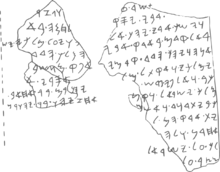Hazael (Damascus)
Hasaël was from about 841 to about 812 BC. King of Aram . The name means " God sees".
The biblical Hazael
The death of Hadad-ezer
Since Hadad-ezer was sick, he sent Hasaël to the prophet Elisha to find out more about the further course of his illness ( 2 Kings 8: 7-8 EU ). Elisha told Hasaël that Hadad-ezer would actually get well again, but would still die. Elisha also foresaw the appointment of Hasael as the new king and the ensuing campaign against Israel ( 2 Kings 8: 10-13 EU ).
Hasaël, after returning to Hadad-ezer, reported the prophecy's recovery ; he kept silent about the rest of the words. The following description of Hadad-ezer's death is ambiguous: And Hasaël went away from Elisha and came to Hadad-ezer, who asked, 'What did Elisha say to you?'. Hasaël said 'Elisha told me you will recover'. The next day he took the bedspread, dipped it in the water and spread it over himself . There he died ( 2 Kings 8 : 14-15 EU ). It is not entirely clear whether by er Hasaël and by about himself (literally: ˁal-pānāw , "about his face") the king is meant, even if the context speaks for it.
After Hadad-ezer's death, Hasael was appointed the new king. ( 2 Kings 8:15 EU )
The war against Joram of Israel
At the same time that Jehu rose up against Joram of Israel and Ahaziah of Judah and killed both, Hasaël waged war against Israel ( 2 Kings 10.32-33 EU ), which he finally won ( 2 Chr 22.5 EU ) .
The war against Joash of Judah
Around the 23rd year of the reign of Joasch of Judah ( 2 Kings 12.7 and 12.18-19 EU ) Hasaël led a campaign against Judah. After Gath was defeated, Jerusalem was his next target. By handing over the temple treasures and paying tribute , Joas was able to end the war and thus became a vassal of Hasaël ( 2 Kings 12.19 EU ).
The historical Hasaël
Hasaël appointed himself between the 18th and 20th year of the reign of Shalmaneser III. to the king and is mentioned accordingly in inscriptions ( Kalach fragment , Kurba'il statue).
In an inscription by Shalmaneser III. (KAH 1.30) Hasaël is referred to as the "son of a no-man", an indication that he might have come to power through a coup against Ben-Hadad II (Adad-Idri) or that he unlawfully ascended the throne after his death. Certainly he did not come from the royal family of Ben-Hadad II, although he pretends to be the "son of Ben-Hadad" in the only fragmentary Tel-Dan stele . The stele found in Tel Dan in 1993 describes the victory in the first year of reign over Joram of Israel and Ahaziah of Judah . According to him, he killed both kings during the battle.
The growing power of Damascus called Assyria on the scene. As part of an Assyrian coalition, Hasaël suffered in 838 BC. A defeat against Shalmaneser III. of Assyria. However, Damascus was not destroyed after the siege. Other campaigns took place on the part of Shalmaneser III. against Hasaël no more. In the last years of Shalmaneser III. and under Shamschi-Adad V (823 to 811 BC) Hasael was able to extend his rule over Palestine and large parts of Syria and, according to Aramaic inscriptions, perhaps even crossed the Euphrates .
Hasael's successor was his son Ben-Hadad III. , whose influence reached as far as eastern Anatolia.
literature
- F. Bron, A. Lemaire: Les inscriptions araméennes de Hazael. In: Revue d'Assyriologie et d'Archéologie Orientale. PAris 83.1989, pp. 35-44. ISSN 0373-6032
- I. Eph'al, J. Naveh: Hazael's booty inscriptions. In: Israel Exploration Journal. Jerusalem 39.1989, pp. 192-200. ISSN 0021-2059
- AK Grayson: Assyrian rulers of the First Millennium BC (858-745). University of Toronto Press, Toronto 1996, ISBN 0-8020-5965-1
- A. Jepsen: Israel and Damascus. In: Archive for Orient Research. Graz 14.1941-1945, pp. 153-172. ISSN 0066-6440
- Brad E. Kelle: What's in a name? Neo-Assyrian designations for the Northern Kingdom and their implications for Israelite history and Biblical interpretation. in: Journal of Biblical literature. Atlanta 121.2002,4, pp. 639-666. ISSN 0021-9231
- J. Kinnier-Wilson: The Kurba'il statue of Shalmaneser III. In: Iraq. London 24.1962, pp. 90-115. ISSN 0021-0889
- Jeffrey Kah-jin Kuan: Neo-Assyrian historical inscriptions and Syria-Palestine. Alliance Bible Seminary, Hong Kong 1995, ISBN 962-7997-10-2
- H. Pognon: Inscriptions semitiques de Syrie, de Mesopotamie et de la region de Mossoul. Imprimerie nationale, Paris 1907.
- J. Strange: Joram, King of Israel and Judah. In: Vetus Testamentum (VT). Leiden 25.1975. ISSN 0042-4935
- Dietz Otto Edzard: History of Mesopotamia. CH Beck, Munich 2004, ISBN 3-406-51664-5
Individual evidence
- ↑ see Shalmaneser III. , Campaigns
- ↑ 2 Kings 8 ( English ) Bible Hub. Retrieved June 21, 2019.
| personal data | |
|---|---|
| SURNAME | Hazael |
| ALTERNATIVE NAMES | Hazael, Hazael |
| BRIEF DESCRIPTION | King of Aram (Damascus) (around 845–815 BC) |
| DATE OF BIRTH | 9th century BC Chr. |
| DATE OF DEATH | 9th century BC Chr. |
